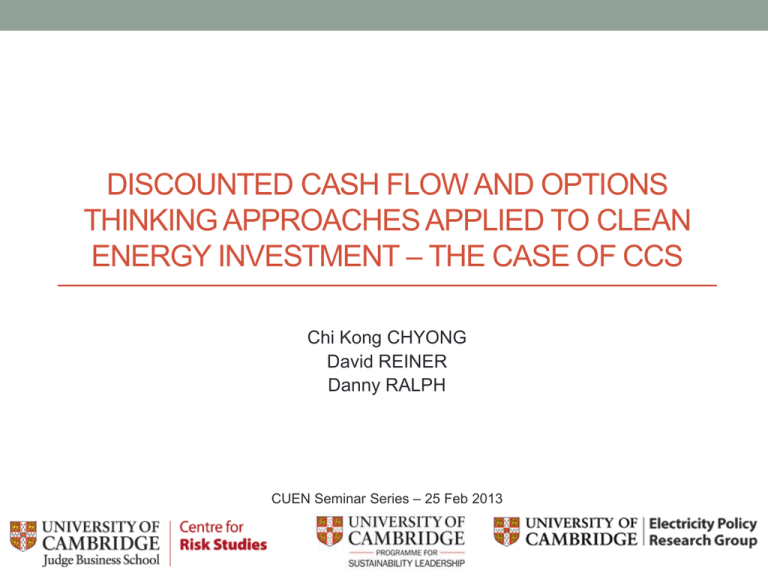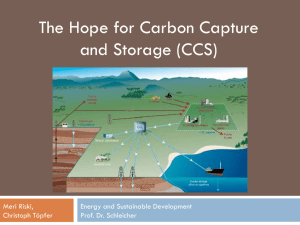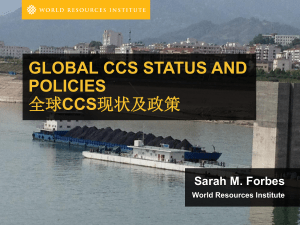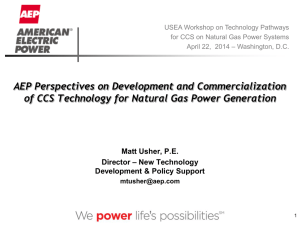ET2013_CCS
advertisement

DISCOUNTED CASH FLOW AND OPTIONS THINKING APPROACHES APPLIED TO CLEAN ENERGY INVESTMENT – THE CASE OF CCS Chi Kong CHYONG David REINER Danny RALPH CUEN Seminar Series – 25 Feb 2013 Background and Overview • Valuation methodologies like Discounted Cash Flow (DCF) do not, on their own, offer an explicit way to incorporate uncertain future market or policy conditions that could have asymmetric impacts on investment performance into valuations. • Nor do they account for managerial flexibility to respond as uncertainties are resolved. • Clean energy investments are particularly exposed to this set of conditions, so such tools could lead to suboptimal investment decisions if not used appropriately. • We conclude that where these conditions of uncertainty exist, enhancing valuation methodologies with approaches that explicitly value embedded optionality to respond should become standard practice. This would formalise some existing market practices. Background and Overview II • Options analysis explicitly treats and acknowledges uncertainties and strategic investment decisions contingent on evolution of key uncertainties • Therefore, our research objective was to examine: “under what circumstances traditional DCF analysis understates the option value of clean energy investment decisions” • Three clean energy investment case studies were analysed: • Natural gas power generation plant with post-combustion carbon capture technology • Offshore wind farm investment in the UK North Sea • Onshore wind farm investment in the US Midwest region • We present the CCS case here, but the full analysis is at: http://www.cpsl.cam.ac.uk/bei#fragment-4 eady exist and are used in both the investment and energy industries (either formally or ly), but their diffusion is still not as wide as is desirable. Figure A illustrates the conceptua ce between valuation methodologies that do, and do not, explicitly value optionality and ts the potential value of that optionality. Why Options Analysis? Probability NPV without optionalities (i.e. DCF value) Expanded NPV with optionalities Value of optionality 0 Profit eed to wer na atory we I's real s can be a emental managers, d financial allocate Real s, when ha counted more ture value mes that uld be lost ojects that (DCF) analysis, so it should not be seen as a separate, or particularly more complicated methodology. Equally, Figure 5 unpacks what is sometimes viewed as an opaque process. How to Use Options Analysis r, Head of ch EMEA, Qualitative asset/project(s) screening & analysis Input data & assumptions Discounted Cash Flow Analysis Traditional valuation approach Distribution of NPVs and Expected NPVs Sensitivity analysis Identification of strategic optionalities Options valuation Net Present Value Expanded NPV (NPV + Optionsa o Value) Reporting & results presentation Options thinking approach vestment valuation methodologies. These circumstances are present for a range of clean en logies, in a range of markets. An options approach should not replace traditional DCF analy mplementary tool to help improve decision-making under challenging conditions. When to Use Options Analysis? Use traditional valuation methodology (eg DCF) Enhance valuation methodology with an options approach Uncertainty is limited and can be credibly quantified Uncertainty is significant and cannot be credibly quantified Shape of probability distribution of future market conditions Close to symmetric Asymmetric, with the possibility of high-impact, low-probability events Management flexibility to change strategy in response to new information Management flexibility is low; investment problem does not have optionality embedded Management does have flexibility; investment problem has optionality embedded Valuation methodology Conditions Degree and nature of uncertainty around future market conditions Evidence of Asymmetries in Key Variables (Henry Hub Gas Price 2003-2012) -2σ 2σ DCF valuation without further quantitative or qualitative assessment may now be performing very differently compared to original expectations. More Evidence of the Dangers of Forecasting 8 io in 2010 Actual price 7 US$/MBTU 6 5 2010 4 2015 3 2020 2 1 0 AEO09 AEO10 AEO11 Sources: US Energy Information Administration (EIA), Annual Energy Outlook (AEO) for 2009, 2010 and 2011 Key Principles Traditional discounted cash flow analysis is unable to reveal strategic project value embedded in optionality in light of great uncertainties • Traditional valuation (such as DCF): present value of Benefits less Costs • Highly sensitive to weighted average cost of capital (discounting): • WACC depends on many factors, such as default premium, inflation premium, CEO’s strategic decision-making ability (options thinking), etc. • Issue: projects with high uncertainties, such as clean energy investment, are penalised with much higher WACC because of high uncertainties; but uncertainties ≠ risks. • Therefore, capital markets put an unjustifiably high premium on clean energy investment. However… Key Principles …Not all uncertainties are risk, and not all risk is bad • Uncertainties have both downsides as well as upsides; thus, uncertainties are both risks and opportunities • Given ability to make strategic investment decisions contingent on evolution of these uncertainties, we can capitalise opportunities and minimize risks embedded in uncertainties • Thus, options have strategic value when there are uncertainties - -> Higher uncertainties increase the options value • Options analysis adds another analytical layer on top of DCF to better value and reflect strategic nature of decision making under uncertainties Carbon Capture and Storage for Natural Gas Power Plant in the UK: Inputs & Assumptions (1) • Decisions: • Power plant investment • CCS (post-combustion) NGCC? • Carbon Capture ready (CCR) NGCC? • Non-CCR (Baseline) NGCC? • Capture plant retrofit (for CCR & non-CCR options): • every two years • Uncertainties: • Gas price & Electricity price (stochastic) • CCS Learning rate (stochastic) • Carbon price (scenarios) • Timeframe: 2013-2033 CCS Decision Tree Carbon Capture and Storage for Natural Gas Power Plant in the UK: Inputs & Assumptions (2) Pipeline CAPEX, £mn OPEX, £mn/year Storage CAPEX, £mn OPEX, £mn/year 139 12.6 74.2 12.8 Valuing Carbon Capture Readiness (CCR) Option Definition & Assumptions • Baseline NGCC is required by the UK law to demonstrate capture readiness, but in essence: • Demonstrate technical ability to retrofit (i.e. engineering report) & enough physical space • CCR option costs £3mn (on top of the baseline NGCC), includes: • Space and foundations reinforcement for turbines • Engineering design to accommodate new solvents & ability to export additional power (from reduced power requirement for solvent regen & CO2 compression) • Thus, CCR can be viewed as an option which gives a power generator the right (but not the obligation) to retrofit the power plant with CO2 capture on or before a future date (the exercise date or expiration). • Given engineering design of the CCR option, its value depends on expectations of CCS deployment in the future, carbon prices & uncertain CCS technology learning. Thus, CCR options value = eNPVCCR – eNPVbaseline – InvCostCCR Carbon Capture and Storage for Natural Gas Power Plant in the UK Inputs & Assumptions (3) • Parameters for modelling gas prices (stochastic process): • Estimated price volatility: 4% • Assumed growth rate : 0.06% • Parameters for modelling power prices (stochastic process): • Estimated price volatility: 7.6% • Assumed growth rate : 0.3% Cost of Equity Risk-free rate (10Y UK Government Bond) Beta Market Risk Premium Cost of Equity Mid-year factor 4.00% 0.51 6.00% 5.03% 102.48% Tax, Inflation and Depreciation Inflation rate 2.40% Tax rate 23% Depreciation method straight line Annual Asset Depreciation 5% Carry Forward if no income to depreciate yes Scenarios for the CCS case study Carbon prices • Carbon price paths: • Base case: corresponds to the UK carbon price floor • Low C-price case • High C-price case (‘Katrina-type’ of hurricanes are more often by 2020) • Carbon price effects on wholesale electricity price (‘pass through’ effect): • 0% (no effect); • 23% - DECC’s average assumption (i.e., £1 increase in C-price increases wholesale price by £0.23) • 50% (i.e., £1 increase in C-price increases wholesale price by £0.5); • 100% (£1 increase in C-price increases wholesale price by £1) this is possible if we believe that fossil fuel generation will dominate the electricity system in the UK (no renewables) DECC’s projection of Carbon and wholesale electricity prices (2012-2030) Scenarios for the CCS case study CCS technological learning • CCS technological learning: • Improvement in capture efficiency • Reductions in CAPEX & OPEX of a capture plant • Technological learning depends on: • Learning rate (tables on the right); modelled stochastically • Global CCS deployment; deterministic scenarios according to the following deployment scenarios (tables on the right) • Central Case for the analysis includes: • Base case C-price • DECC’s assumption regarding the effect of C- price on wholesale electricity price (23% pass through) • Base case CCS technological learning: • Base case rate of global CCS deployment & Base case learning rates for capture efficiency improvements and cost reductions Learning rate scenarios: Efficiency of Capture Min Max Most likely High 11% 18% 15% Base* 4% 6% 5% Low 2% 3% 3% * Based on survey of literature Learning rate scenarios: CAPEX of Capture Min Max Most likely High 18% 51% 33% Base* 6% 17% 11% Low 3% 9% 6% * Based on survey of literature Learning rate scenarios: OPEX of Capture Min Max Most likely High 30% 90% 66% Base* 10% 30% 22% Low 5% 15% 11% * Based on survey of literature Global CCS deployment rate (% pa): 2013-2033 High 40.00% Base 10.00% No CCS 0.00% IEA (2010) assumes global deployment of 470 GW of powergen with CCS by 2035 (70% of all coal generation), or 17% p.a., in its most ‘optimistic’ CCS scenario CCR Investment as a Hedge under Different Carbon Prices and Learning Rates Conclusions CCS Case study • In general, gas power plants (and gas with CCS) in the UK seem to be priced out of the market by the UK’s carbon price floor unless carbon costs can be passed through to consumers (which partly depends on the deployment of renewables in the UK). • CCR optionality has minimal impact in the high profit (low carbon price) scenario, but provides a significant benefit for the lower profit (base and high carbon price) scenarios • A natural next step is to conduct a portfolio analysis where we would, for example, value CCS and wind and other lowC generation technologies (e.g., nuclear) • THANK YOU FOR YOUR ATTENTION!







